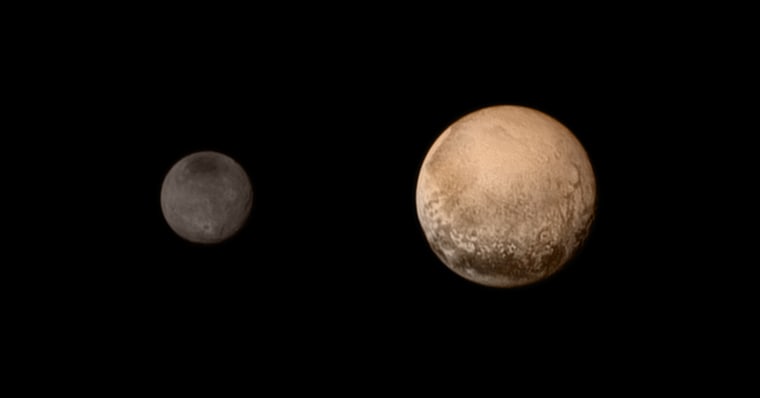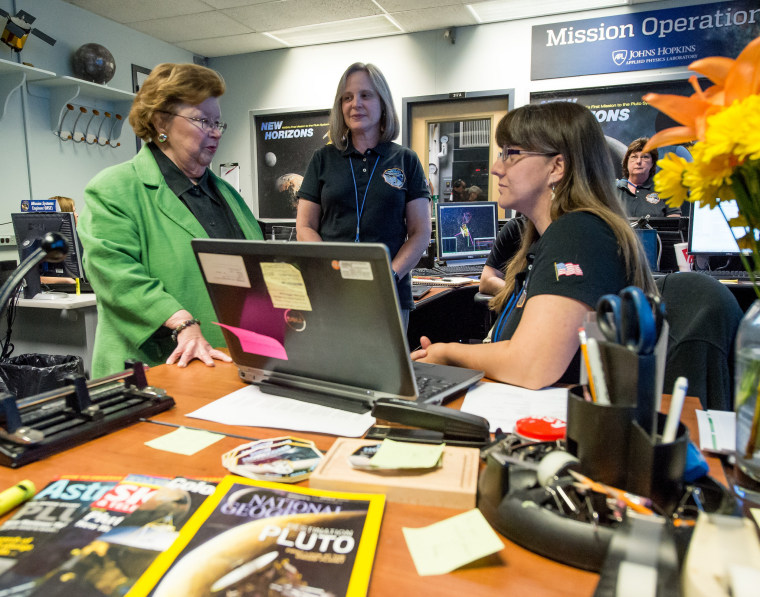LAUREL, Md. — With less than a day to go before NASA's New Horizons mission zooms past Pluto, scientists reported on Monday that the dwarf planet isn't quite as dwarfish as they thought — in fact, it's the largest known solar system object beyond Neptune.
How large? Based on New Horizons imagery, its diameter is 2,370 kilometers (1,473 miles), plus or minus 20 kilometers (12.4 miles). That makes it almost 30 miles wider than Eris, the dwarf planet whose discovery led to Pluto's downfall as the "ninth planet" back in 2006. Eris' diameter has been measured to be 2,326 kilometers (1,445 miles), plus or minus 12 kilometers (7.5 miles).
"This settles the debate about the largest object in the Kuiper Belt," the wide ring of icy material that lies outside the orbit of Neptune, said New Horizons principal investigator Alan Stern.
Stern said New Horizons' observations also confirmed that Pluto has a polar ice cap, and that the composition of that cap is different and more methane-rich than the dark bands and splotches of material ringing Pluto's equator. The piano-sized probe's instruments also have detected atoms of nitrogen escaping from the dwarf planet's atmosphere, Stern said.

Elsewhere in the Plutonian system, New Horizons' measurements confirmed that Charon, Pluto's largest moon, is 751 miles (1,208 kilometers) across — and that the smaller icy moons Nix and Hydra are 20 and 30 miles (35 and 45 kilometers) wide, respectively.
Monday's revelations, shared during a news briefing here at Johns Hopkins University Applied Physics Laboratory, were just a foretaste of the findings that are expected after the spacecraft's close flyby at 7:49 a.m. ET Tuesday.
On Monday, New Horizons gathered up a system-wide scan of data and imagery from the approach and sent it down to Earth, as a "fail-safe" measure in case the spacecraft somehow doesn't survive the flyby. Stern said that computer models estimate the chance of New Horizons running into a damaging piece of cosmic debris at less than 1 in 10,000, but there's enough uncertainty to keep the team at APL on edge.
The last transmission before the flyby was due to be received on Earth on Monday night, marking the start of a 22-hour period when the spacecraft will be so occupied making observations that it won't be sending telemetry back to Earth. The fail-safe imagery is to be released Tuesday, while the team is waiting for confirmation from the spacecraft that it survived the encounter.
Because Pluto is almost 3 billion miles away, it will take 4.5 hours of travel time at the speed of light for the all-clear signal to reach Earth. If and when that moment comes, sometime around 9 p.m. ET Tuesday, it will set off a cheering, jumping-for-joy celebration at APL's Mission Operations Center.
"Tomorrow evening's going to be a little bit of drama," Stern said Monday.
New Horizons was launched nine and a half years ago on a $728 million mission to map Pluto and its largest moon, Charon, as well as to learn about their composition, take measurements of other moons in the Plutonian system and study Pluto's thin atmosphere.

The size issue has loomed so large because Pluto's so small. When Eris was discovered in 2005 at a distance of 9 billion miles (15 billion kilometers), scientists estimated it to be bigger than Pluto — setting off a debate over the definition of planethood.
A year later, the International Astronomical Union voted to reclassify both worlds as "dwarf planets" because there were thought to be lots of other objects like them in their orbital neighborhood. Later observations showed that Eris was indeed about 27 percent more massive than Pluto — but that they were close to the same size.
Astronomers were able to get relatively precise measurements of Eris' diameter, thanks to occasions when the dwarf planet's disk blocked out the light from distant stars. But the light-bending effect of Pluto's atmosphere made such measurements less precise. New Horizons' imagery helped scientists nail down a better estimate, Stern said.
He said the fact that Pluto is bigger than previously thought implies that it also has more ice and less rock than previously thought. That fact intrigued Caltech astronomer Mike Brown — so much so that he said it might be worth sending a probe to Eris, the dwarf planet he helped discover.
"Odd that Eris is a tiny bit smaller than Pluto but so much more massive," Brown tweeted. "They are quite different bodies in many ways. Maybe we should go."
NASA's New Horizons mission will be the subject of a broadcast starting at 7:30 a.m. ET Tuesday, a news briefing at 8 a.m. and a special "Phone Home" broadcast at 8:30 p.m. Tuesday, all airing online via NASA TV.
